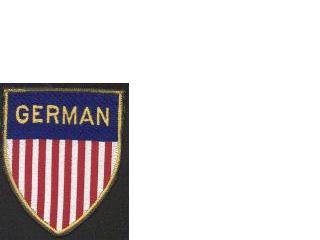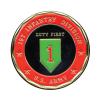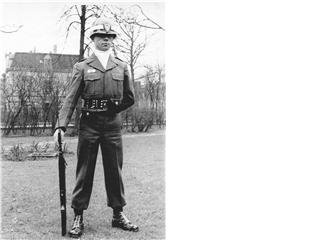-
Posts
58 -
Joined
-
Last visited
Content Type
Profiles
Forums
Blogs
Gallery
Events
Store
Posts posted by Long Thrust VI
-
-
Your speculation is probably correct, Sapper. U.S. Army's German labor battalions wore a "GERMAN" English language patch. There are others on this site with more knowledge than I.
 0
0 -
I recall seeing East German personnel wearing the "field cap" (last photo) in 1963. The cap is the same shape as the "M-43" style made famous by the WW II Afrika korps except the cloth strap was attached over the cap's crown (as shown).
West German troops wore caps of the same style on which the cloth strap attached in front, as the original.
0 -
Thank you, Uwe, for setting me straight. This is a good site to become educated.

Thanks, again, Jock for your generosity. If there's a change of heart, I'll get back in contact with you.
 0
0 -
That's generous of you, Jock -- I'd love to have 'em but got rid of nearly all my collections a few years ago & don't want to start over at my age. Thank you.
Everyone on this page will probably recognize that at least one (& perhaps more) of the photos are of men wearing Bundesheer rather than BGS uniforms.
0 -
On 2/3/2016 at 06:17, Jock Auld said:
Glad its of interest. The reverse of the Press shot of the parade states General Müller? Looks like he served WW2 judging by the ribbon bar.
There was a BGS General Heinrich Muller who served in North Africa during WW II. General Muller led BGS efforts in the "Battle of Gorleben" to confirm West Germany's right to survey parts of the Elbe River in spite of communist East German interference.
0 -
Jock, this is excellent! Few North Americans are aware of the BGS & its history. Keep up the good work!
John
0 -
Gordon, my only recollection of gray uniforms worn by 6941 Guard Battalion is from 1963. In later years, I'm told, Guard uniforms were standard U.S. Army OG-107 "fatigues" (I assume with appropriate insignia).
0 -
6941st Guard Battalion has a website: http://www.guardbattalion.de
During my 1963 U.S. Army service in West Berlin, 6941st Guards wore gray uniforms, cut in the style of U.S. Army's short "Ike Jackets," with black U.S. combat boots & helmet liners as shown above. Here are two photos sent by a former 6941st Guard with whom I'm in regular contact.
0 -
VERY NICE! In 1963, West German units at Wildflecken often sang traditional songs while marching. One of those songs, as I recall, was named Erika.
0 -
A Vietnam Veteran (supply clerk for a 155 mm howitzer battery) told me he was sleeping on a cot in the supply tent when his base came under rocket fire. A sliver of shrapnel penetrated the tent, grazing his right-small toe -- for which he was awarded the Purple Heart for a combat wound. Although the wound was slight (almost nonexistent) the award was legitimate.
0 -
The vehicle appears to be a Borgward B2000, one of the first military vehicles to enter service with the West German Federal Armed Forces. Between 1955 & 1961, 5,672 were produced according to MILITARY VEHICLES (2003) by Chris McNab.
0 -
Duarte 1223, regarding that red-painted helmet: Red helmets were often worn by the officer or non-commissioned officer in charge of a "hot" (live-fire) firearms range.
0 -
In about 1956, U.S. Army Military Police armbands were redesigned & enlarged (they're now called brassards) so as to include the parent unit's shoulder sleeve insignia ("shoulder patch"). The brassard includes a loop on its top to fit over the shirt's or jacket's left shoulder loop, to hold it in place. If the garment is without shoulder loops, the brassard is held in place by use of a safety pin.
0 -
During the U.S. military occupation of West Berlin, Germany (1945 - 1990), a Kaserne there was named McNair Barracks in honor of General Lesley McNair. It was formerly a Telefunken assembly facility for communications equipment & taken by occupation forces for use as troop billets. McNair Barracks was home to Soldiers of 6th U.S. Infantry & 502nd U.S. Infantry. More recently, it has become an apartment/condominium complex.
0 -
Absolutely! This is good stuff!
John
0 -
Chances are good the photos are from 1961. I was thinking they may have been taken earlier & developed in 1961. In terms of personal equipment, weapons, uniforms, etc., the Bundesheer was a new & dynamic organization in the 1950s & early 1960s. A lot of insignia items were adopted & changed during those years. Originally, West German Infantrymen wore crossed rifles insignia, reminiscent of that worn by U.S. Infantrymen. That didn't last long & was soon replaced by traditional German "two-ribbon" collar insignia w/branch of arm colors. By 1963, high, pull-on "dice-box" boots had replaced the original British-style lace-up short boots w/gators. Early West German Soldiers wore "splinter" camouflage (not unlike the Wehrmacht) field uniforms replaced shortly thereafter by heavy wool dark-olive field uniforms referred to as "the felt louse" because of their rough, itchy texture. Given that all, or nearly all, senior officers & non-commissioned officers were WW II Veterans, uniform items were influenced by Wehrmacht experience. In the early 1960s, for example, West German military police wore traditional "chain dog" plaques, hanging by a chain around their necks, to identify themselves a MPs.
0 -
As mentioned above, 3rd Infantry Regiment, & it's subordinate units, has an impressive history. 3rd Infantry was active throughout the Cold War. About 1946, the Regiment served several months in occupied West Berlin, Germany.
0 -
My impression, based on uniforms, etc., is that those photos are actually pre-1961; perhaps mid-late 1950s. From my personal observation at Wildflecken, some Bundeswehr Soldiers were armed with Belgian-made FN rifles as late as 1963.
0 -
For the purposes you describe, Speagle, there appears to be no reason to keep two of each DUI. As far as a market, you might look around online or attend militaria collector shows.
0 -
Sir, as you say, the "buff strap" is part of the distinctive unit insignia (DUI) of the 3rd U.S. Infantry Regiment. It is worn, however, around the LEFT shoulder. Around the right shoulder of 3rd Infantry Regiment Soldiers is worn the Infantry blue cord, as worn by all qualified U.S. Infantrymen.
0 -
Gentlemen:
Please provide information as to why ribbons of the Iron Cross 2nd Class, & certain other decorations (i.e. Ostfront Medaille), were traditionally worn on the tunic's second button hole rather than displayed on a "rack" over the left breast pocket as are other ribbons. Is Germany the only nation to adopt this tradition? When & where did this practice originate? Thank you.
Regards,
John
0 -
There was a time, especially in the 1950s, when insignia & painted designs on helmet liners approached something of an art form. The most unique design I saw was worn by cadre of a 9th Infantry Division Field Artillery battalion at Ft. Carson, Colorado. The unit's "totem" was the ram -- cadre's helmet liners were Artillery red with gold colored, curved ram horns, similar to football helmets worn by the Los Angeles Rams NFL team.
0 -
Growing up not far from Cheyenne Mountain (inside which North American Air Defense Command [NORAD] lurked) it was assumed that, sooner or later, the Soviets would launch an attack & we would all die in a nuclear holocaust. For whatever reason, that didn't seem to concern us very much -- it was just Cold War reality. Volunteering for service in the Ground Observer Corps & later the U.S. Army, was my way of performing my patriotic duty to the Free World (at least, that was my perception).
Regards, John
0 -
Gentlemen:
Here's one you may have missed: THE EAST GERMAN ARMY (1968) by Thomas M. Forster (Originally published 1966 in Koln, West Germany as NVA -- DIE ARMEE DER SOWJETZONE). Not a detailed description of medals & awards but an early, 255 page, hard bound, English language reference book regarding the communist East German Army's historical development, organization and equipment, personnel, training, political indoctrination, & operations. It includes a large selection of black & white photographs & diagrams of Iron Curtain fortifications. A rare Cold War document.
Regards,
John
0





The East German Border Guard Uniforms from 1962
in Germany: Post 1945: Bundesrepublik & DDR
Posted · Edited by Long Thrust VI
Here is a photo taken summer 1963 of the Berlin Wall in the French Sector. East German Border Guards wearing uniforms as described are seen on the other side of the Wall on a raised observation platform.